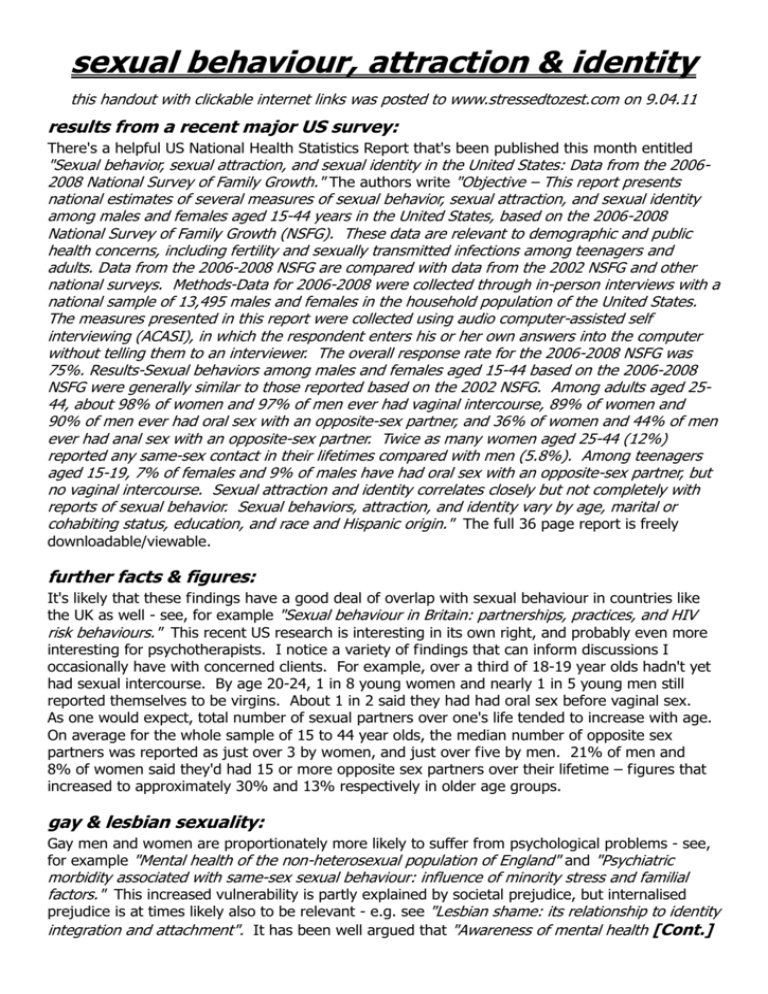
sexual behaviour, attraction & identity
this handout with clickable internet links was posted to www.stressedtozest.com on 9.04.11
results from a recent major US survey:
There's a helpful US National Health Statistics Report that's been published this month entitled
"Sexual behavior, sexual attraction, and sexual identity in the United States: Data from the 20062008 National Survey of Family Growth." The authors write "Objective – This report presents
national estimates of several measures of sexual behavior, sexual attraction, and sexual identity
among males and females aged 15-44 years in the United States, based on the 2006-2008
National Survey of Family Growth (NSFG). These data are relevant to demographic and public
health concerns, including fertility and sexually transmitted infections among teenagers and
adults. Data from the 2006-2008 NSFG are compared with data from the 2002 NSFG and other
national surveys. Methods-Data for 2006-2008 were collected through in-person interviews with a
national sample of 13,495 males and females in the household population of the United States.
The measures presented in this report were collected using audio computer-assisted self
interviewing (ACASI), in which the respondent enters his or her own answers into the computer
without telling them to an interviewer. The overall response rate for the 2006-2008 NSFG was
75%. Results-Sexual behaviors among males and females aged 15-44 based on the 2006-2008
NSFG were generally similar to those reported based on the 2002 NSFG. Among adults aged 2544, about 98% of women and 97% of men ever had vaginal intercourse, 89% of women and
90% of men ever had oral sex with an opposite-sex partner, and 36% of women and 44% of men
ever had anal sex with an opposite-sex partner. Twice as many women aged 25-44 (12%)
reported any same-sex contact in their lifetimes compared with men (5.8%). Among teenagers
aged 15-19, 7% of females and 9% of males have had oral sex with an opposite-sex partner, but
no vaginal intercourse. Sexual attraction and identity correlates closely but not completely with
reports of sexual behavior. Sexual behaviors, attraction, and identity vary by age, marital or
cohabiting status, education, and race and Hispanic origin." The full 36 page report is freely
downloadable/viewable.
further facts & figures:
It's likely that these findings have a good deal of overlap with sexual behaviour in countries like
the UK as well - see, for example "Sexual behaviour in Britain: partnerships, practices, and HIV
risk behaviours." This recent US research is interesting in its own right, and probably even more
interesting for psychotherapists. I notice a variety of findings that can inform discussions I
occasionally have with concerned clients. For example, over a third of 18-19 year olds hadn't yet
had sexual intercourse. By age 20-24, 1 in 8 young women and nearly 1 in 5 young men still
reported themselves to be virgins. About 1 in 2 said they had had oral sex before vaginal sex.
As one would expect, total number of sexual partners over one's life tended to increase with age.
On average for the whole sample of 15 to 44 year olds, the median number of opposite sex
partners was reported as just over 3 by women, and just over five by men. 21% of men and
8% of women said they'd had 15 or more opposite sex partners over their lifetime – figures that
increased to approximately 30% and 13% respectively in older age groups.
gay & lesbian sexuality:
Gay men and women are proportionately more likely to suffer from psychological problems - see,
for example "Mental health of the non-heterosexual population of England" and "Psychiatric
morbidity associated with same-sex sexual behaviour: influence of minority stress and familial
factors." This increased vulnerability is partly explained by societal prejudice, but internalised
prejudice is at times likely also to be relevant - e.g. see "Lesbian shame: its relationship to identity
integration and attachment". It has been well argued that "Awareness of mental health [Cont.]
issues for gay men and lesbians should become a standard part of training for mental health
professionals" and there are encouraging findings reported from use of self-help methods –
“Expressive writing for gay-related stress: psychosocial benefits and mechanisms underlying
improvement." In this month's US report on sexual behaviour, " ... twice as many women as men
report having had any same-sex sexual contact in their lifetimes (13% of women and 5.2% of
men)". In part this difference is due to broader questioning on sexual behaviour for women's
same-sex behaviour than for men's. However even restricting the questions, 9.3% of women
aged 15 to 44 reported having had oral sex with another woman compared with the 5.2% of men
reporting having had oral or anal sex with another man. When questioned about their sexual
identity, approximately 94% of women and 96% of men (aged 18 - not 15 - to 44) stated that
they were ‘‘heterosexual or straight''. Interestingly " ... for women, those who reported four or
more opposite-sex partners in their lifetimes were more likely to report any same-sex experience
(20%) or same-sex oral sex (16%) than those with fewer or none." Only about 1% of women
identified themselves as lesbian while 3.5% said they were bisexual, and another 1.7% didn't
answer the question or reported themselves as "something else". For men (aged 18 to 44), the
equivalent figures were 1.7% gay, 1.1% bisexual, and 1.5% not answering or reporting "something else". Our "sexual identity" is likely to be determined by a complex of factors and to be on
a continuum rather than being categorical - see, for example "Male homosexuality: nature or
culture?", "Evidence that male sexual orientation is a matter of degree", "Female bisexuality from
adolescence to adulthood: results from a 10-year longitudinal study" and "Sexual orientation in a
U.S. national sample of twin and nontwin sibling pairs".
Important territory – relevant for all of us, psychotherapists and general public alike!








